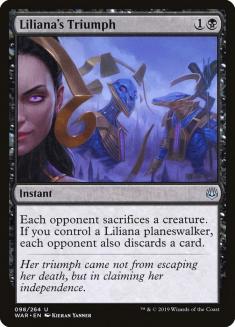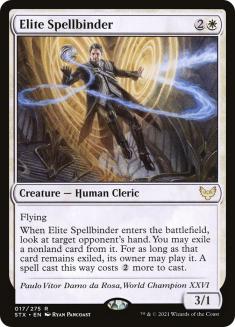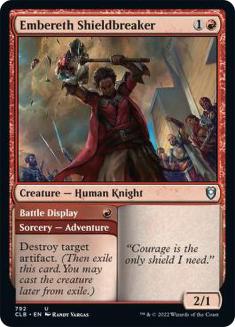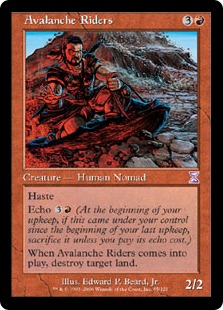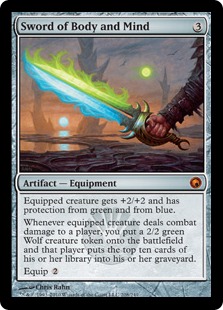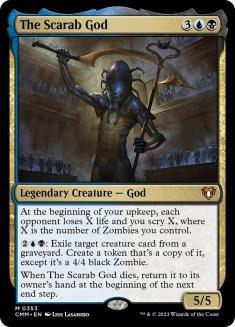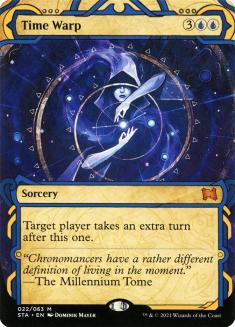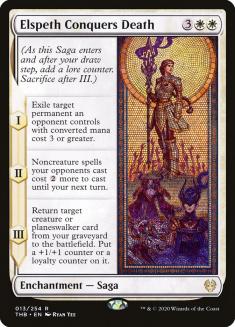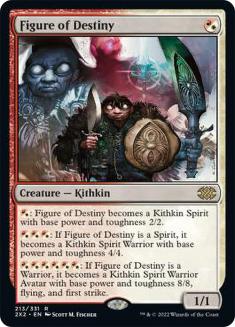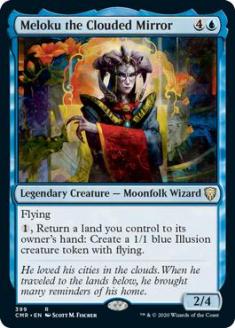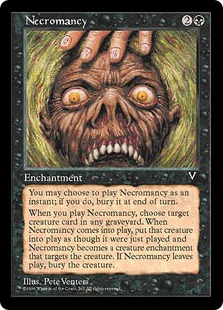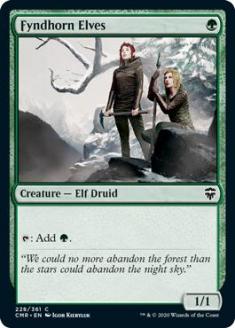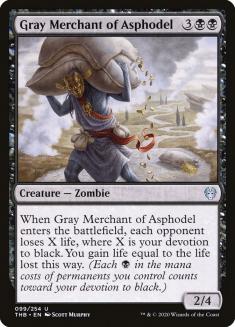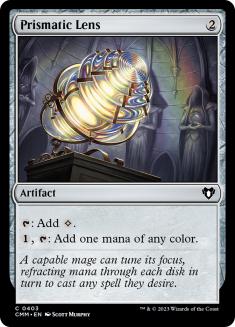In case you haven’t heard, the Legacy Cube has returned to Magic Online (MTGO). We’re one week in at this point, but there’s still a full week ahead of MTGO’s second-most-powerful Cube offering. Last week I offered a general breakdown of the Cube, and today I’ll be taking a more in-depth look at a specific draft.
We’ll start where most drafts do, by going over Pack 1, Pick 1. I’ll post the pack, break down the most notable options, and then finally highlight what I picked, how things went from there, and retrospective thoughts on the draft.
You’re facing down these fifteen cards. What’s the pick?
Pack 1, Pick 1
The Pack:
The Pick:
Examining My Options
My number one Cube card from Strixhaven! Elite Spellbinder comes with a solid body and an ability that can generate some very meaningful tempo. What I like about Elite Spellbinder is that the stats are good enough to either play in an aggressive deck or to cast en route to your higher-impact spells in more controlling shells. This pick would make it easy to move in on Mono-White Aggro and wouldn’t make it terribly difficult to move in on blue if I were passed better blue cards. Blue is, after all, the most powerful color in Legacy Cube, so even when drafting nonblue cards I like to ask how well they play in blue decks.
The best Sword. The most miserable Sword. The gameplay with this one isn’t remotely compelling, but it’s hard to argue with the power level of Sword of Body and Mind in 40-card formats. Equipment cards are a bit easier for opponents to manage than some of the other most powerful cards in the Cube by their nature, but picking this one up will often net you a free win against a green deck. That’s a pretty high return on drafting one card.
The Scarab God is a resilient threat and value engine. It comes with so much text and stats that the card is realistically good in any matchup. I do have two reservations about the card. The first is that if you want five-mana cards that are generically good to top off your curve, they aren’t hard to come by and The Scarab God is not the best of the lot. The second is that while blue is the best color in the Cube, black is among the worst. I’ll happily move in on black for a card like Ashiok, Nightmare Weaver or if the Dimir lands are going late, but first-picking The Scarab God is on the aggressive side for my taste.
Similar to The Scarab God, Time Warp is a somewhat replaceable “near the top of the curve”-type effect. That said, the ceiling on taking an extra turn is very high and the floor is very low. Assuming that it resolves, it’s possible for Time Warp to be weak, but it’s not really possible for it to be bad. It’s also mono-blue, so there are definitely things to like here. A high-floor, high-ceiling card in the best color in the Cube is a great place to start.
If I want to be aggressive, this is my creature. I firmly believe that the white aggressive decks are better than the red aggressive decks in the current iteration of the Legacy Cube, though the ability to slot into either is upside. This pack isn’t deep on good cards for either color, though once you factor in the Sword of Body and Mind I would expect that a card for an aggressive strategy will come back, albeit with low odds that it’s one that I’m happy to play. Avalanche Riders just isn’t as powerful as the other red fours and Embereth Shieldbreaker doesn’t have the volume of targets in the Cube that I would like to happily draft it. The real prize would be seeing Elite Spellbinder on the way back, but I consider this outcome to be pretty unlikely.
In the absence of tutors to make Reanimator decks absurdly redundant, you’re required to just draft more reanimation effects to make these decks work in Legacy Cube as opposed to Vintage Cube. You could make a strong case that Reanimator has the highest power-level ceiling of any archetype you could draft in the Cube, and following that logic I could get behind forcing the deck. That all said, Necromancy is among the weaker reanimation effects, and you’ll need to see a lot of specific things to reward you for making this pick. A respectable option, though not a flexible one.
The green ramp deck in Legacy Cube is nearly identical to what you can draft in Vintage Cube. Fyndhorn Elves and other mana creatures combined with Gaea’s Cradle, Natural Order, and Craterhoof Behemoth are a force to be reckoned with. These decks want a high volume of cheap mana creatures, so it makes sense to draft them early and often. Taking the only green card out of the pack definitely sends good signals, though the other side of this is that you won’t get a green card on the way back from this pack. Fyndhorn Elves is absolutely powerful enough to pick here. You’ll just have to keep a close eye on potentially moving in on a second color.
Finally, we come to the option that best stays open. In the absence of Signets and Talismans, mana rocks like Prismatic Lens are premium. I would play as many as I could get in basically any non-aggressive deck. It will generally have higher value over replacement than any five-drop, and will be the best Turn 2 play in a lot of controlling decks. The other options make an argument for drafting something specific, whereas Prismatic Lens is the pick if you’re hoping to see something better later.
So What’s My Pick?
Influenced some by my desire to get in more reps with Elite Spellbinder, I took the card with the intention of finding my way into an Azorius deck if it was open or landing on white aggro if it wasn’t. Pick 2 yielded a Student of Warfare, and Pick 3 netted me a Hallowed Fountain without any aggressive options. I also got Glacial Fortress somewhere in Pack 1 though never saw a spell that pulled me into blue. Instead, I ended up in the slightly awkward camp of drafting a white aggressive deck but not wheeling the Figure of Destiny. I played this to a 2-1:
Creatures (15)
- 1 Mother of Runes
- 1 Cloudgoat Ranger
- 1 Flickerwisp
- 1 Student of Warfare
- 1 Hero of Bladehold
- 1 Blade Splicer
- 1 Porcelain Legionnaire
- 1 Thalia, Guardian of Thraben
- 1 Restoration Angel
- 1 Containment Priest
- 1 Kytheon, Hero of Akros
- 1 Giver of Runes
- 1 Clarion Spirit
- 1 Glorious Protector
- 1 Elite Spellbinder
Lands (17)
- 17 Plains
Spells (8)

My mana curve was on the high side, and if I knew what the packs were going to look like, it would be easy to trade the Spellbinder for Figure of Destiny to smooth things out. My loss was to an opponent who had Turn 2 Liliana, the Last Hope in two games and also had Natural Order, so I don’t know that things would have gone much better for me either way. The matches that I won were fairly lopsided in my favor, and even against the nonsense I lost to, I took it to three games and could’ve stolen one with a slightly better draw.
Ultimately, that’s why I would stick with the Elite Spellbinder pick over Figure of Destiny. It was a hedge that resulted in a solid deck while shooting for the ability to draft a powerful blue deck if the packs lined up correctly. Obviously I would love it if I could just 3-0 every draft, but the way the cards fell, I believe I found the most open lane, drafted a cohesive deck, and hedged in ways to give myself a shot at playing some of the most powerful cards in the Cube like Fractured Identity and Mystic Confluence if they showed up.
After getting pulverized by Liliana, there’s a part of me that would like another go with the Prismatic Lens, but as they say, sometimes you just lose.


